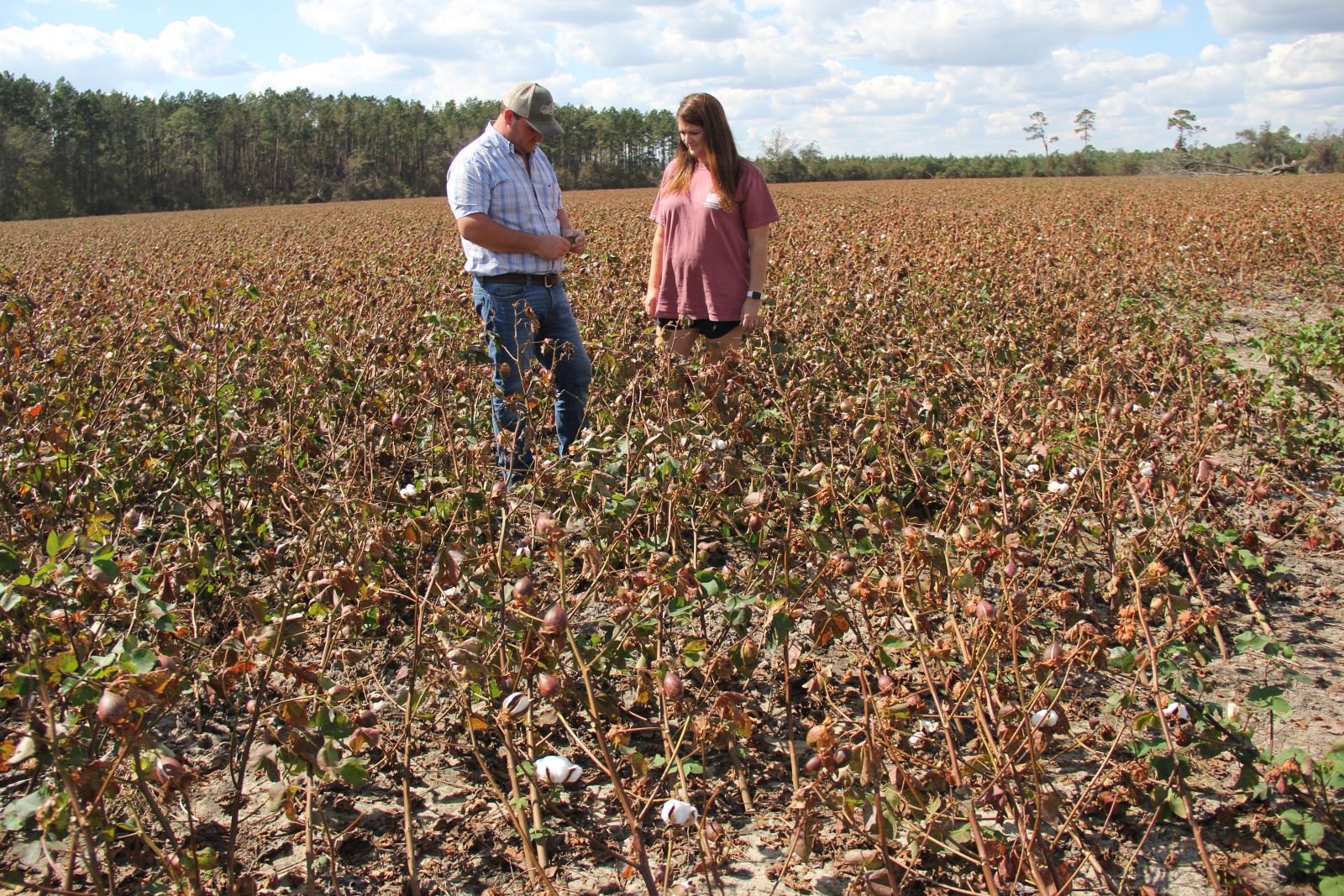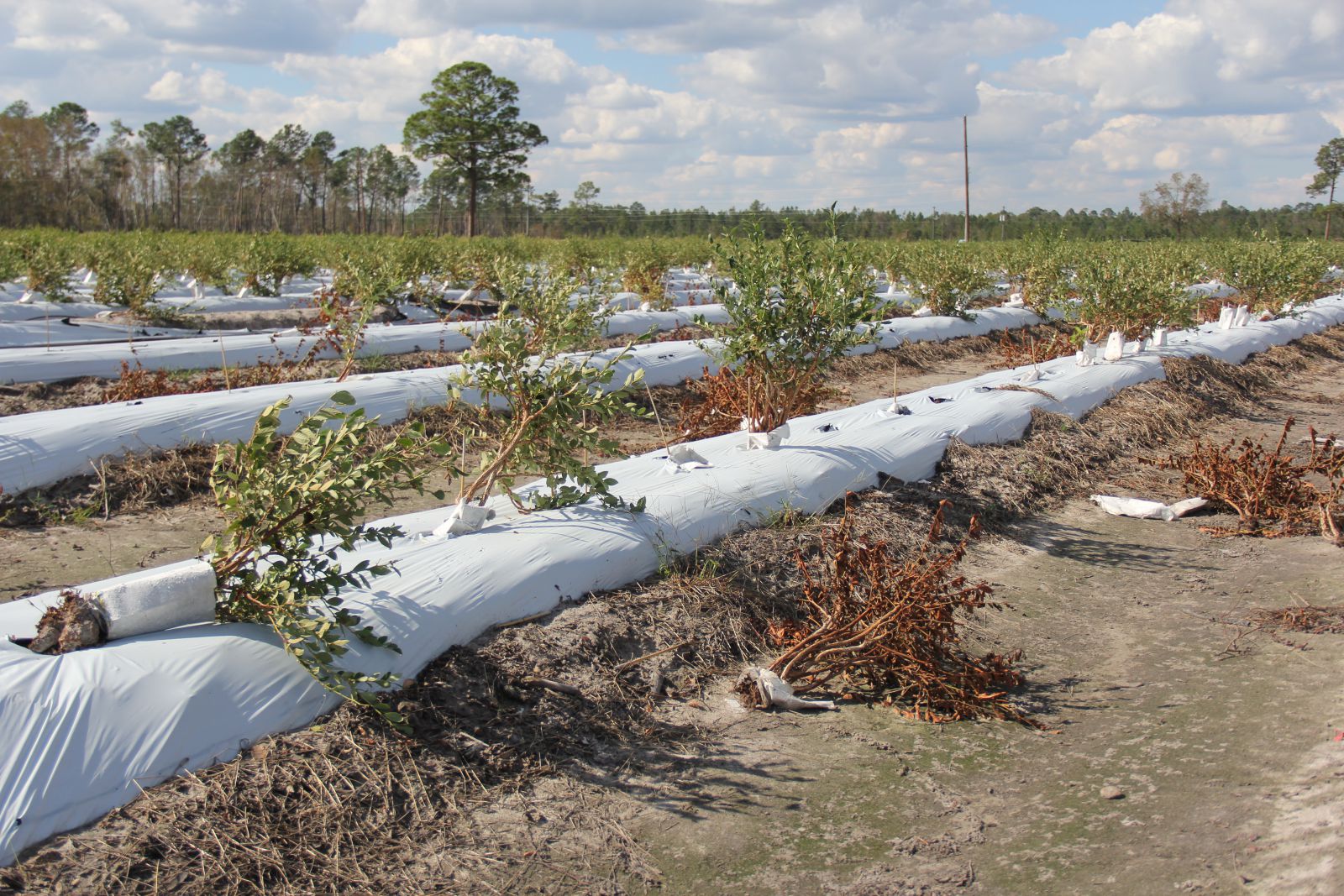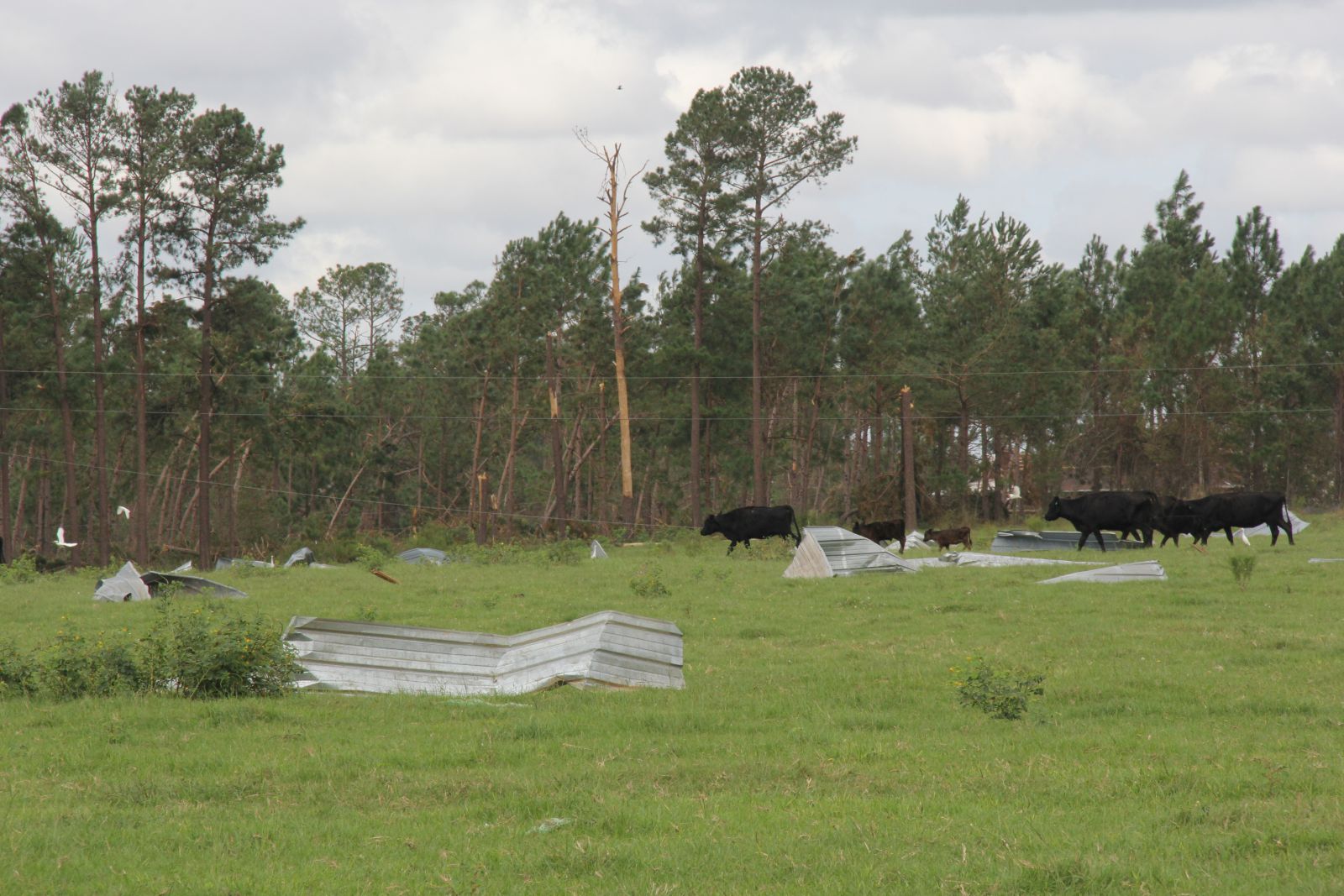Ag News
Helene wreaks havoc on Georgia crops and timber
Posted on Oct 13, 2024 at 2:31 AM
The heavy rains and high winds of Hurricane Helene that pummeled Georgia on Sept. 26 into the morning of Sept. 27, caused an estimated $6.46 billion in agricultural and forestry losses across Southeast Georgia in a stretch from Valdosta to Augusta and over to the coast, according to a preliminary study released by the University of Georgia. Final damage loss amounts are expected to rise after row crop and pecan farmers harvest what remains of their crops. State officials say this estimate should be interpreted as preliminary, as it will take months to understand the full scope of Helene’s damage.
The storm left many of the state’s farmers improvising to run their livestock and poultry operations and many are still living without electricity. All of Georgia’s major commodities took horrific hits.
Hurricane Helene is the third named storm to hit Georgia in the past 13 months – Hurricane Idalia Aug. 30, 2023 and Tropical Storm Debby Aug. 5, 2024 - and it could not have come at a worse time for Georgia farmers, who were already facing economic hardship caused by inflation, high input costs and depressed commodity prices. Prior to Helene, U.S. Net Farm Income was projected to drop by $6.5 billion in 2024, following a decline of $35.6 billion in 2023.
On Thursday, Oct. 10, Gov. Brian Kemp and Georgia Agriculture Commissioner Tyler Harper were joined by members of Georgia’s Congressional delegation and state legislators at a press conference on the farm of brothers Terry and Ronnie Phillips in Treutlen County to discuss the damage done to Georgia’s agriculture and forestry sectors which contribute more than $83 billion to our state’s economy on an annual basis and employ more than 320,000 Georgians according to the latest UGA Ag Snapshots report. /Photo by Jennifer Whittaker
"The damage that you see around you here - twisted cotton, broken and twisted pine trees - it's representative of what we've seen from Valdosta to Augusta, the entire impact zone of Hurricane Helene. It is catastrophic, widespread damage that has impacted every rural community and farm in the storm's path. Before Hurricane Helene, we had an ag economy that was in dire straits due to low [commodity] prices and high production costs. Our farmers need help right now to help them through this and to make it to the next growing season," Commissioner Harper said. "We hope the federal government will implement a block grant program soon to allow each state affected by Helene to help their farmers. We can't wait six months or a year."
Gov. Kemp and First Lady Marty Kemp have visited numerous communities ravaged by Helene since Sept. 27, seeing the destruction first-hand as they’ve met with storm survivors, local leaders, first responders and linemen working to help affected areas recover.
"We depend on our farmers and timber growers to provide the food and fiber we use every day and that drives our economy as part of Georgia's No. 1 industry," said Kemp. "Following the immense losses caused by Hurricane Helene, I'm urging all of our local, state, and federal partners to join efforts in bringing them relief. That's why we're calling on the federal government and Congress to act quickly in appropriating relief funds and helping them rebuild their livelihoods."
Having visited numerous affected communities, Georgia Farm Bureau President Tom McCall said, “Our thoughts and prayers go out to all Georgians facing the devastation of Hurricane Helene. While we are still assessing the extent of its impact, this storm has already disrupted lives and caused significant damage, particularly within our farming communities. Georgia's producers are resilient. They’ve weathered storms before, and they will do it again. Georgia Farm Bureau stands ready to support our farmers as they work to recover and continue providing the food, fiber, and resources that sustain us all. In times like these, our strength comes from standing together and moving forward."
TIMBER
Hurricane Helene traversed 8.8 million acres of timber and had a total impact of $1.28 billion on Georgia’s timber sector, Georgia Forestry Commission Director Johnny Sabo said. This tract of damaged timber was shot in Treutlen County. / Photo by Jennifer Whittaker
“Forestry changed overnight in this state,” Sabo said. “The detriment Hurricane Helene caused to our private landowners will take years to clean up. This area where we are today is considered the wood basket of the state. On top of the financial impact there’s also an impact to landowners’ mental well-being.”
According to a report compiled by the Georgia Forestry Commission and peer reviewed by the UGA Warnell School of Forestry, private forested land accounted for 88% of the impacted land owned in the hurricane’s path. Wind graphics from Peachtree City National Weather Service indicated wind speeds from 60-100 miles per hour from Valdosta to Augusta.
A mobile data collection application was utilized by GFC foresters to gather more than 2,800 field observations from Valdosta to Augusta. The observations detailed tree species, product class, percent damage, and location to make up damage intensity levels. Timber damage was classified as catastrophic, moderate and light.
GFC recommends that homeowners call certified arborists https://www.treesaregood.org/findanarborist or licensed tree services for major tree debris removal and proper maintenance of remaining trees.
Hazardous trees and limbs should be removed. However, major pruning should be delayed six to 12 months (preferably during the winter months). Sometimes, tree mortality takes at least that long or even longer to occur, so major expenditures before then would be wasted. When it appears the tree will survive, more careful pruning and continued fertilization (with deep watering, if necessary) is recommended.
County extension offices https://extension.uga.edu/county-offices.html can conduct soil tests to determine pH and nutrient levels. Based on the results, homeowners may need to help preserve the tree by fertilizing the tree, aerating the soil, mulching the tree’s root area and watering if soil conditions become excessively dry.
It’s important to keep in mind that storm debris cleanup can take weeks or even months.
Helpful resources for timber owners available on the GFC website include:
Forest debris management program practices
https://gatrees.org/wp-content/uploads/2020/01/Forest-Debris-Management-Program-Practices.pdf
How to evaluate and manage storm-damaged forest areas
https://gatrees.org/wp-content/uploads/2020/01/stelprdb5448015.pdf
Manage storm-damaged trees do’s and don’t’s
Https://gatrees.org/wp-content/uploads/2019/11/dos-and-donts-storm-tree.pdf
Selling storm-damaged timber
https://gatrees.org/wp-content/uploads/2020/01/Selling-Storm-Damaged-Timber-Final.pdf
Storm damage information for landowners
https://gatrees.org/wp-content/uploads/2020/01/GFCStormDamageManagementWeb-2.pdf
National timber tax website
Timber tax credit
https://dor.georgia.gov/timber-tax-credit
POULTRY
Southeast Georgia poultry producers lost about 800 houses to Helene and are estimated to have suffered $500-$520 million in damages, according to the preliminary loss estimates released by the UGA College of Agricultural & Environmental Sciences (CAES) on Oct. 10.
Jeff Davis County Farm Bureau Director Vann Wooten, who grows broilers (chickens for meat) for Pilgrim’s Pride was hit hard. He’s raised broilers for 41 years. /Photo by Jennifer Whittaker
“I’ve never seen anything like this in my life. I’ve seen spots where tornadoes have touched down, but this goes on and on all over the county. The storm broke timber 50 years old. I’ve got one [chicken] house left standing, and it has some damage, but I’m trying to get it fixed so we can get birds back in it. A timber patch kept the brunt of the wind off it,” Wooten said. “I just lost my source of income and my retirement fund to this storm. We [farmers] don’t need a disaster loan. We [farmers] need a grant so we can get back up and farming.”
Wooten said he’s slept very little since the storm struck.
“I’ve worked my whole life for this farm. How am I going to stay here? How am I going to make a living?” Wooten asked. “I’m willing to build back with some help. All I know is farming cattle and chickens and row crops.”
Thankfully, the chickens in the house had just recently been caught before the storm struck.
“I don’t want people feeling sorry for me, but if we’re [the U.S. government] going to send money to other countries, let’s throw it down here and help our own country first.”
Jeff Davis County Farm Bureau Director Jamie Tate sustained heavy damage at his poultry farm that includes four houses where hens lay table eggs sold in grocery stores. The roof of one of his layer-houses completely collapsed. The other three houses sustained a lot of damage. /Photo by Jennifer Whittaker
Tate estimates that ¾ of the house with the collapsed roof is gone. The other three houses lost at least 30% of the tin off their roofs. One of the houses had no chickens. The hens remained in two of his houses unharmed and birds in the collapsed house were lost.
Helene also ripped off about 2/3 of the tin roof on the poultry stackhouse at Tate’s farm. This shed is used to store poultry litter and let it dry out before it’s applied to fields as fertilizer.
As of the morning of Oct. 11, the Tates were still without power and running their layer houses on generators.
“That’s another job for us just to keep the generators running. It takes an hour every morning to fill up all the gas containers for the day that we use to run the generators,” Jamie explained. He estimates he can run one of his four generators for nine hours on seven gallons of gas.
Tate wasted no time getting a contractor from Dothan, Ala., to begin repairing his houses. By Friday, Oct. 4, the crew had a few panels of new tin nailed over the easiest-to-fix holes Helene left on his chicken house roofs. The panels of shiny new tin offered hope of a new beginning amidst the chaos Helene left on the Tate farm.
In addition to damaging their chicken houses, the Tates lost about 15 old-growth pecan trees that made a small orchard at the farm's entrance. A mule barn, built in the 1940s, that was the farm's symbolic heart was heavily damaged.
"There's no telling how many family photos that have been made in front of this barn," Tate said.
The devastation at these two poultry farms has occurred at farms in Appling, Bacon, Coffee, Evans and Tattnall along with many other counties in Helene’s path from Valdosta to Augusta.
PECANS
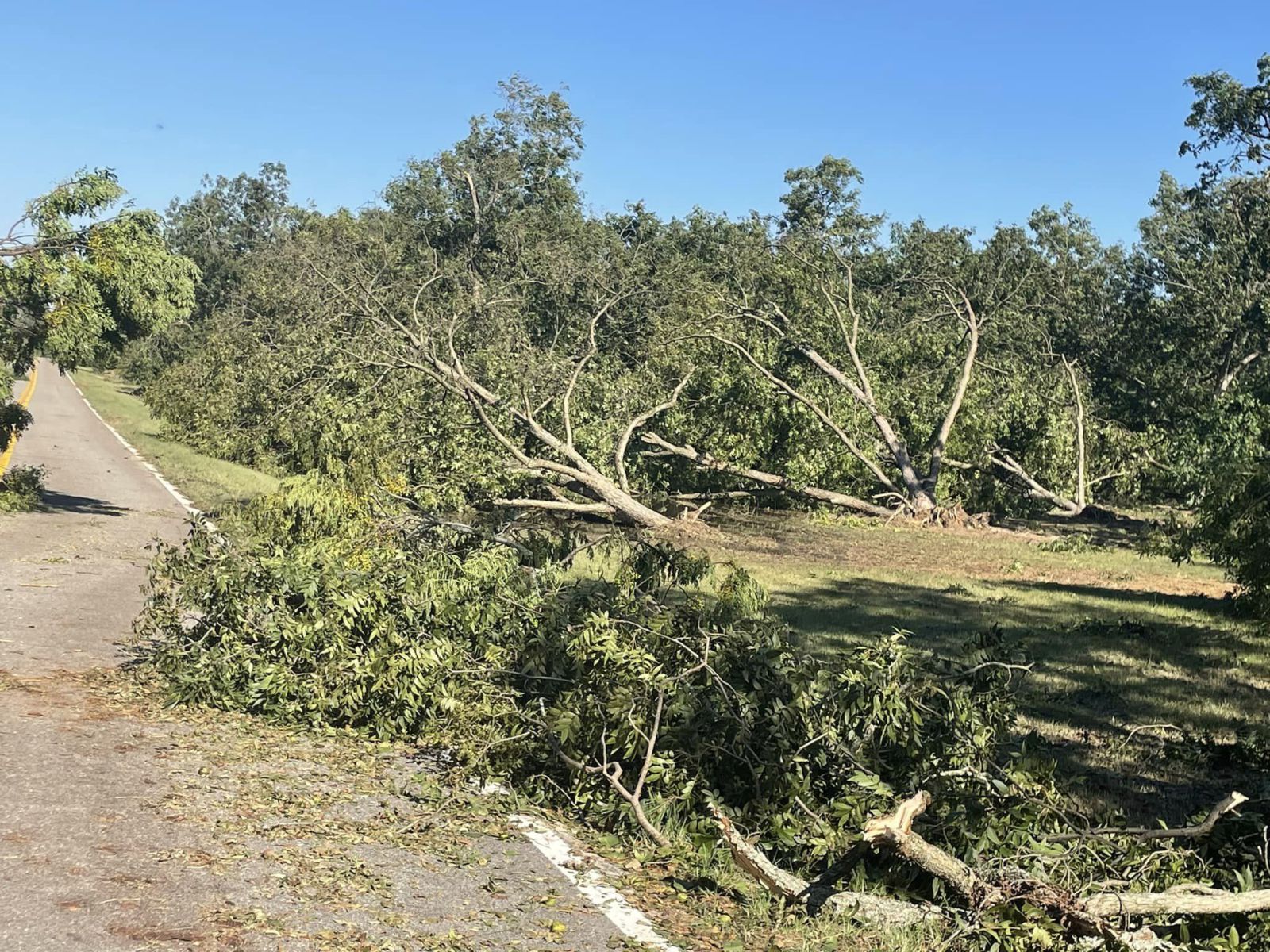
This pecan orchard in Jefferson County belongs to Sam Pennington and is representative of the 420,000 pecan trees UGA estimates Helene blew down from Brooks County to Augusta. /Photo by Wesley Sparks.
Georgia pecan growers took a major hit that is being described by growers and industry leaders as a generational loss, with entire orchards of trees blown over, wiping out not only this year’s crop but those of future years, too.
In Washington County, Willis Hartley lost approximately 75% of the trees on his 180-acre orchard. It remains to be seen whether the ones left standing can be harvested.
“We were four weeks from harvest,” Hartley said. “Before we can get in there to harvest we have to get all the downed trees cleaned up.”
Hartley, age 80, had a stroke in 2022 and has worked his way back to being able to work the farm, which he bought in 1968.
“You know, it's heartbreaking,” Hartley said. “I just sat down and cried. I had to work this long to accumulate this orchard, make it look like it did, and then to lose it … yeah, it's terrible.”
UGA’s preliminary loss damage report estimates Georgia lost at least 420,000 pecan trees. The crop loss of pecans blown to the ground is estimated at $62 million while the cost to replant uprooted and damaged trees is $76 million for a total of $138 million. The loss of future income is estimated to be $417 million.
“We’ve had a little over a week to sort through the damage wrought by Hurricane Helene upon our pecan industry. It’s a difficult thing to see in person and to put into words. We have not seen a storm with this level of destruction in the past,” UGA Extension Pecan Specialist Dr. Lenny Wells wrote in his Oct. 7 pecan blog. “The damage begins in Brooks and Lowndes counties and extends north, north-east about 260 miles. Almost all the damage is east of I-75 once you reach Tift County.”
Wells said growers should be aware that USDA Farm Service Agency has provided a waiver to allow farmers to self-assess damage without waiting for FSA personnel to visit farms.
“Just be sure to take photos of the damage and keep up with hours of labor and each piece of equipment used during cleanup for use when ECP funds are made available. Growers should contact their local FSA to sign up for ECP beginning October 15, 2024,” Wells wrote.
Wells said most remaining upright trees lost the largest percentage of their nuts when they were blown off the trees still in their green shuck. These are not salvageable, Wells wrote. Even if the nuts inside the shuck are far enough along to be mature, if the shucks won’t open it is not economically viable to de-shuck them.
“There is no way to know for sure at this point how much of the remaining crop in storm-damaged areas will continue to mature normally and be eligible for harvest. There will likely be a lot of variation and almost assuredly some losses. Leaning trees which continue to have enough root to keep the trees green and alive will likely continue to mature some of their nuts, although that depends on the damage to shucks and stems in each tree,” Wells wrote. “If these nuts do open normally, the nuts will likely be marketable but check them and be aware that the potential for quality loss is there, even at a late stage, if the flow of water and nutrients to those nuts has been affected."
Pecan damage is extremely heavy in Atkinson/Coffee/Bacon Counties then straight north to Soperton, Vidalia and Lyons, UGA Southeast Area Pecan Agent Andrew Sawyer wrote in his Oct. 10 pecan blog. Sawyer says the eye wall looks to have traveled between/around GA Hwy 19 and U.S. 221 to Dublin until turning towards Augusta.
“There is also significant pecan damage further east of the path. Throughout Appling County and Reidsville you could find orchards that survived. It changes from more consistent 60%(+) tree loss to varying 30% to 70% tree loss on that eastern edge,” Sawyer wrote. “Douglas and Alma do not have a significant amount of older orchards as they do younger orchards. If you follow U.S. 221 north, we have consistent tree loss/pecan damage throughout Montgomery and Toombs counties. Even in Emanuel County there were orchards with 75% tree loss.”
Visit https://site.extension.uga.edu/pecan/ to read the latest pecan updates provided by Wells and Sawyer.
HORTICULTURE/PLANT NURSERIES
Georgia's horticulture sector was hit hard and is estimated to have sustained $450 million in damage to crop loss, future income, and greenhouses & other infrastructure, per the UGA CAES preliminary damage report issued Oct. 10.
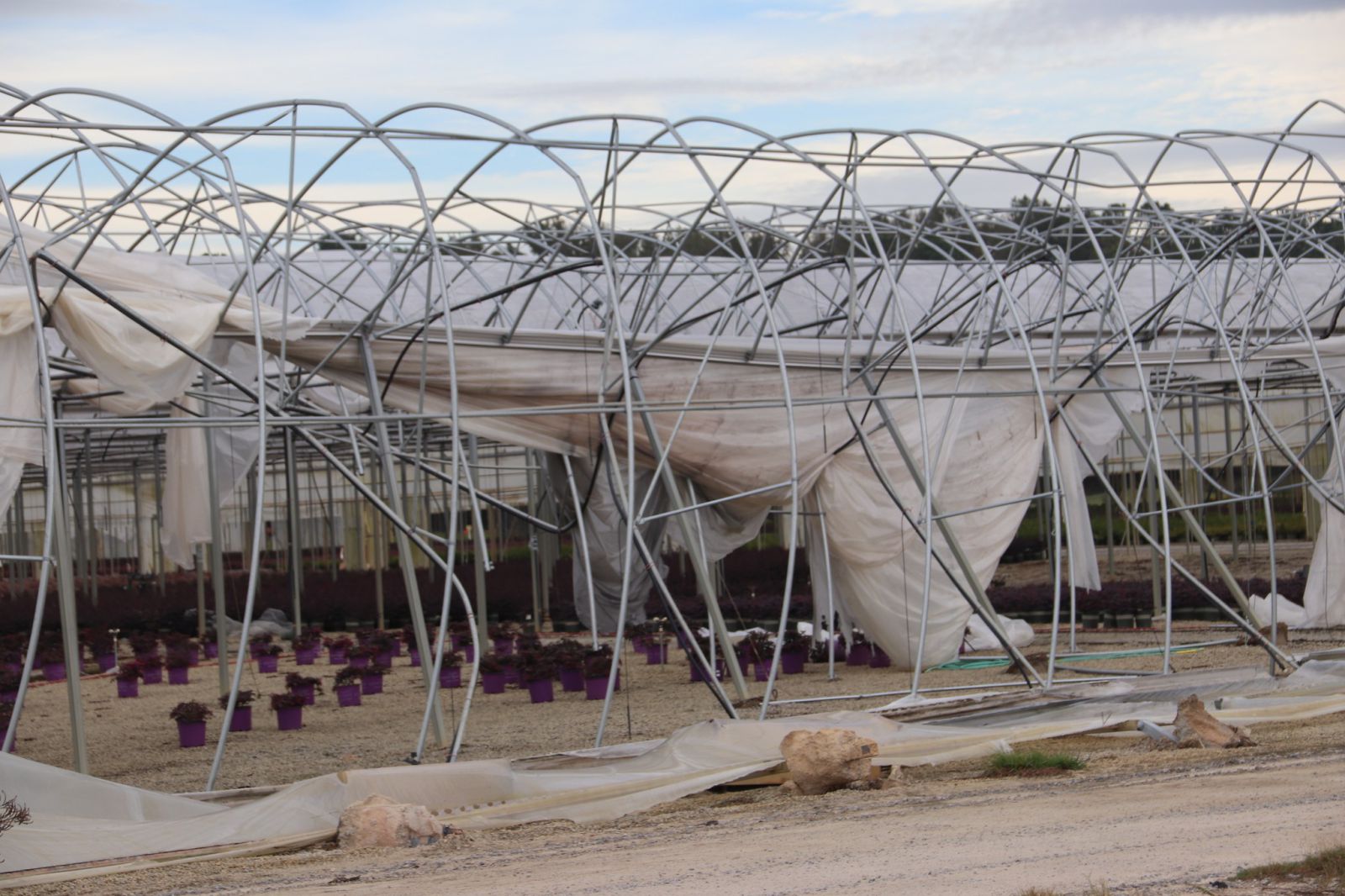
A common sight at McCorkle’s was torn plastic sheeting that covers greenhouses. Skeetter McCorkle said this structural design was chosen because of its ability to handle loads of snow./ Photo by Jay Stone
At McCorkle Nurseries in McDuffie County, lost power meant lost irrigation, and winds damaged or destroyed numerous greenhouses on the farm. Skeetter McCorkle said nearly all of the farm’s 6 million potted plants had turned over and had to be sat back up.
McCorkle’s normally pumps 4 million gallons of water per day for irrigation. A week after the storm, the farm was irrigating at half capacity thanks to loaned generators.
“That’s enough to keep the plants alive,” Skeetter said.
McCorkle, a longtime Farm Bureau member who serves on the GFB Board, lost some cedar trees his family planted in the 1960s next to the nursery’s main office. Within a few days, the nursery was back to shipping orders of plants.
COTTON
Fields of cotton that would normally look as if Georgia had received a fall snowstorm have been blown out and cotton stalks are blown over or tangled together. The UGA CAES preliminary damage report issued Oct. 10 estimates the equivalent of 500,000 to 600,000 bales of cotton have been lost resulting in a crop loss between $207-$220 million.
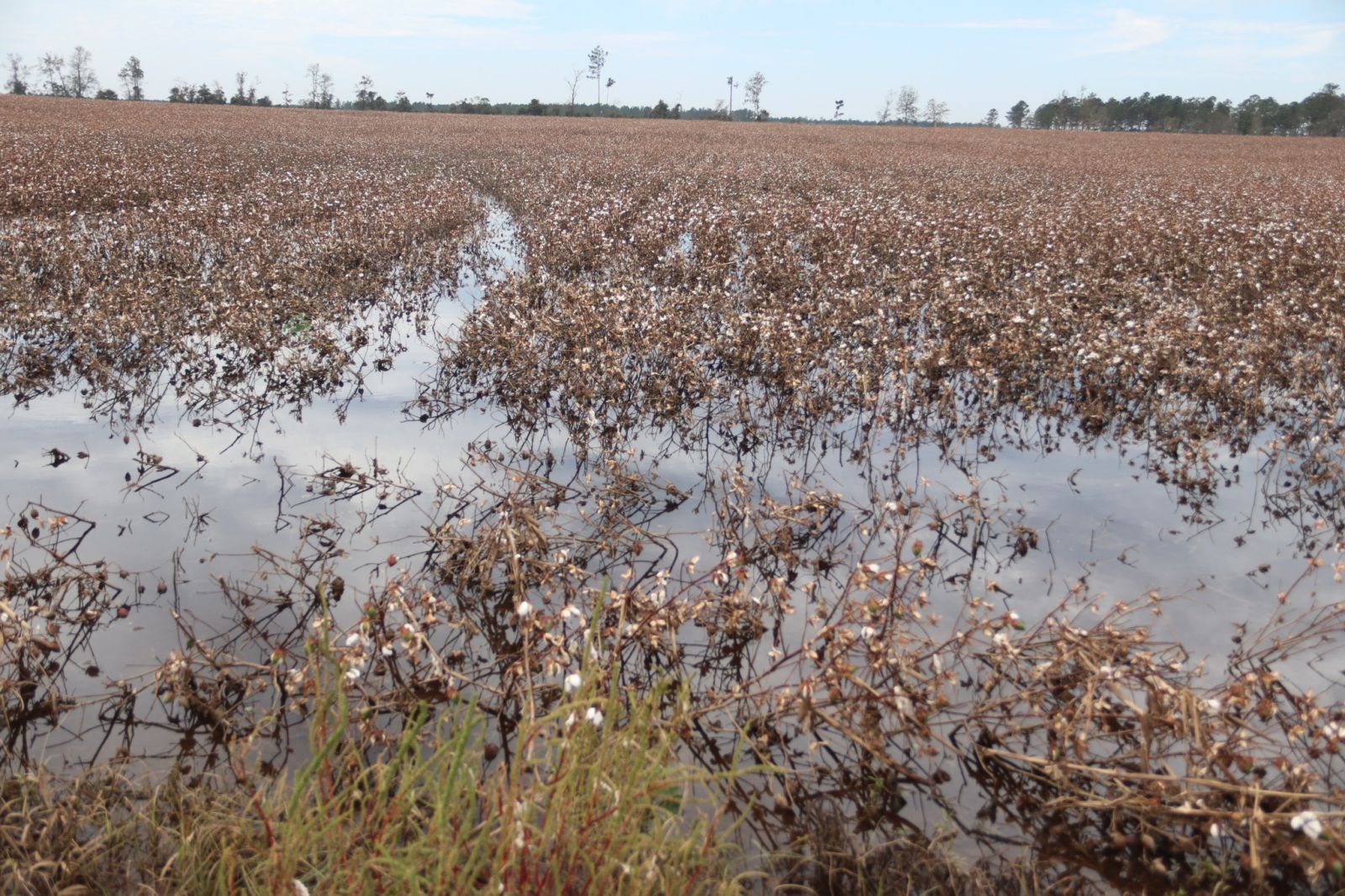
A Washington County cotton field still had standing water four days after Helene passed through./Photo by Jay Stone
In Wrightsville, Johnson County Farm Bureau Vice President Hugh Veal had cotton stalks blown over, but then stood back up. Veal said he thought the crop loss might be minimal a couple of days after the storm because looking at a defoliated cotton field, he noticed a normal amount of white cotton still on the plants. Closer inspection revealed a number of problems, though.
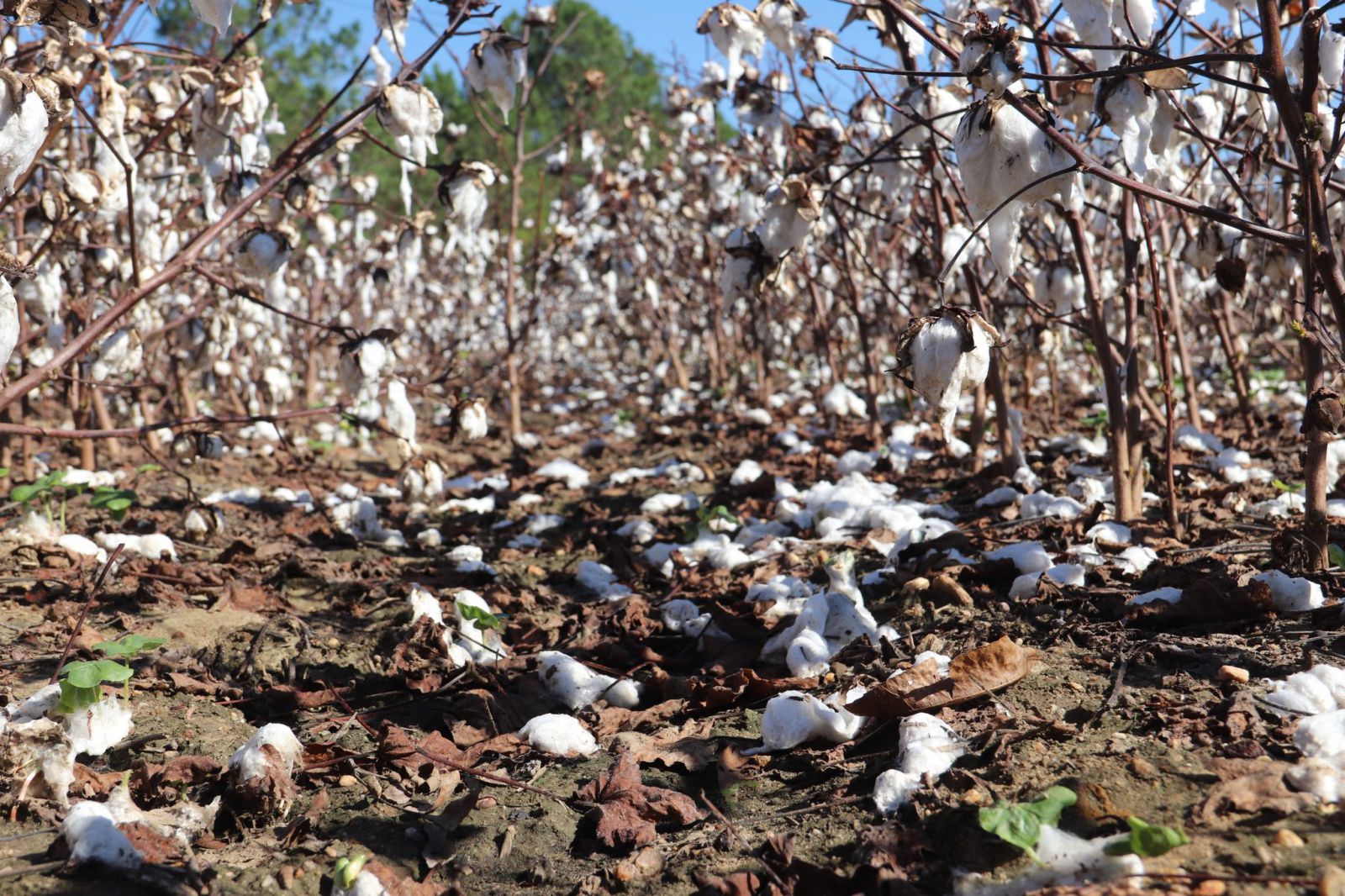
About 20% of Hugh Veal’s cotton fiber was blown off the plants onto the ground, rendering it unusable./ Photo by Jay Stone
The rest remained wet for days, resulting in the white fibers becoming stained and inundated with material from the rest of the plant. Whatever fiber can be harvested will be graded a lesser quality, making it less valuable. Plus, many of the bolls aren’t large enough to be caught by spindles in the combine at harvest.
“It's a mess,” Veal said. “I don't think it's going to be worth picking. I mean, by the time you pay a man to pick the cotton, you don't have any money left, and it's not going to grade well because of the stains in the cotton. All we do is farm. It's just hard. You work and try to do things right. Then it goes haywire.”
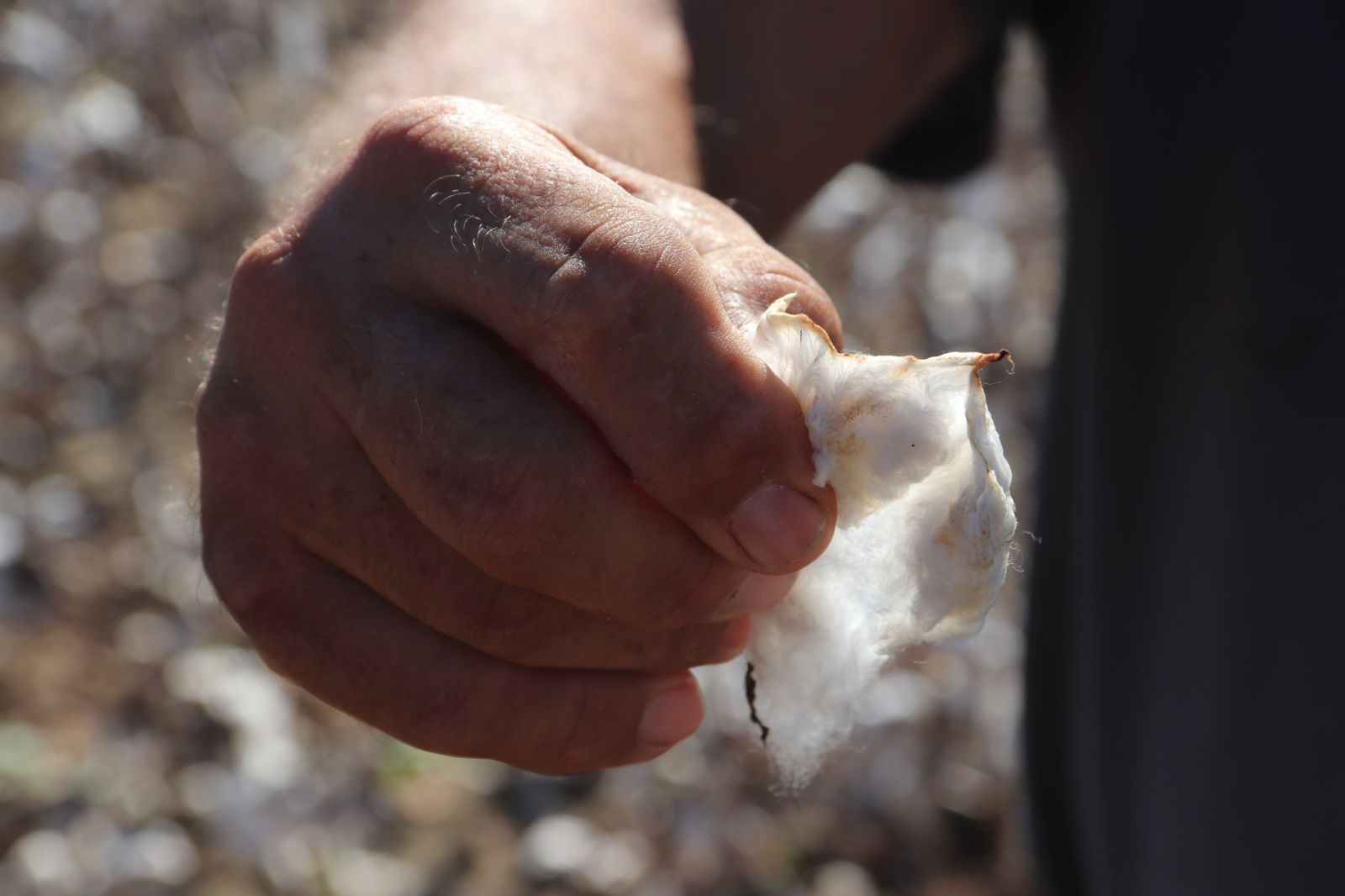
Hugh Veal shows how just a few days after the storm the cotton fibers already showed signs of staining because of contact with wet hulls./ Photo by Jay Stone
Johnson County Extension Agent Rocky Tanner estimated a 70% loss in that particular field.
At the Ware County farm of David and Lindsey Morgan, in Millwood, Hurricane Helene blew cotton stalks over in all their fields.
Helene left one of the Morgans’ fields, where all the plants were green before the storm, a scorched, red color. David said this field was a month away from being ready to be defoliated (sprayed to make the leaves fall off so the cotton picker equipment takes in less plant material as the crop is harvested). The cotton bolls had barely begun to open.
David & Lindsey Morgan look at a field of late cotton that Hurricane Helene blew over on their Ware County farm. All of the plants were green before the storm, now, most of the plants look as if they’ve been scorched. /Photo by Jennifer Whittaker
“Whether or not I pick this cotton will depend on what my insurance agent says,” David said. “It may cost more to run the picker than what we would get for the cotton that may come on and make.”
Lindsey, who teaches high school and grew up on a row crop farm, said, “We’ve never had a storm like this. Normally, when a hurricane comes through it only means a free day from school. This time it’s serious.”
The Morgans had 3 weeks of rain during May, which delayed planting their cotton. Some fields had to be replanted.
“This year has been an issue from the beginning. We had the wet planting season that made getting the crop in the ground an issue, followed by a dry spell in July. 2024 has been a ‘gift’ that keeps on giving,” David said.
Another field of the Morgans’ cotton is about 5 miles away from the field that was scorched since the storm. David is hopeful the plants will remain green, but the storm blew the stalks to the ground.
“As blown over as the cotton is in this field, it makes me feel better because the plants are still green,” David said. “The plants may live long enough to let the [cotton] bolls mature. “Picking blown over cotton like this will give you a heart attack because of how the stalks tangle in the picker.”
In Treutlen County, cotton grower Terry Phillips, said, “We spent five months growing this cotton crop and in three hours it’s gone.”
While some of the crop is salvageable, Phillips estimates they will have between $500,000 to $750,000 in losses.
Terry, along with his brother, Ronnie, hosted the Oct. 10 press conference where state officials announced preliminary ag and timber losses.
“This farm has been in our family since the Revolutionary War. We’re not going to let it stop on our watch,” Terry said. “We’re not going to give up nor quit.
BLUEBERRIES
Georgia’s blueberry sector sustained an estimated loss of $202 million - $52 million in damaged bushes that will need to be replaced and about $150 million in future crop loss, according to the UGA CAES preliminary damage report issued Oct. 10.
Helene completely uprooted younger bushes just planted and left many bushes leaning on their sides. This shot was taken at the Ware County farm of Alex Cornelius./ Photo by Jennifer Whittaker
BEEF CATTLE
Georgia’s beef cattle producers are estimated to have suffered $198 million in loss of cattle, fencing and other infrastructure. When they lost power, the electric pumps on their water troughs stopped working making it necessary for many cattle producers to haul fresh water from creeks or streams if they had them. The Georgia Cattlemen’s Association coordinated an effort through which livestock sale barns across the state served as a place where water was brought in on tankers for cattle producers to fill up containers to take back to their farms.
Cattle on Vann Wooten's farm in Jeff Davis Cattle seem unphased by all of the tin Hurricane Helene ripped from the chicken houses next to their pasture. /Photo by Jennifer Whittaker
One pressing concern for cattle and dairy producers is replacing or repairing fences.
In Jefferson County, Daniel and Robert Newberry had miles of fencing down, much of it the result of fallen trees.
“You’ve got to get the cows hemmed in so you get them back on enough grass to where you don’t have to feed them. You’re going to shut them in to the best area you can so you can fix that fence so they’ll stay put,” said Daniel Newberry, who said their farm has miles of fences down. “We’re just getting what we can situated for the cows so we can start on peanuts, because we’re going to start digging here in a few days.”
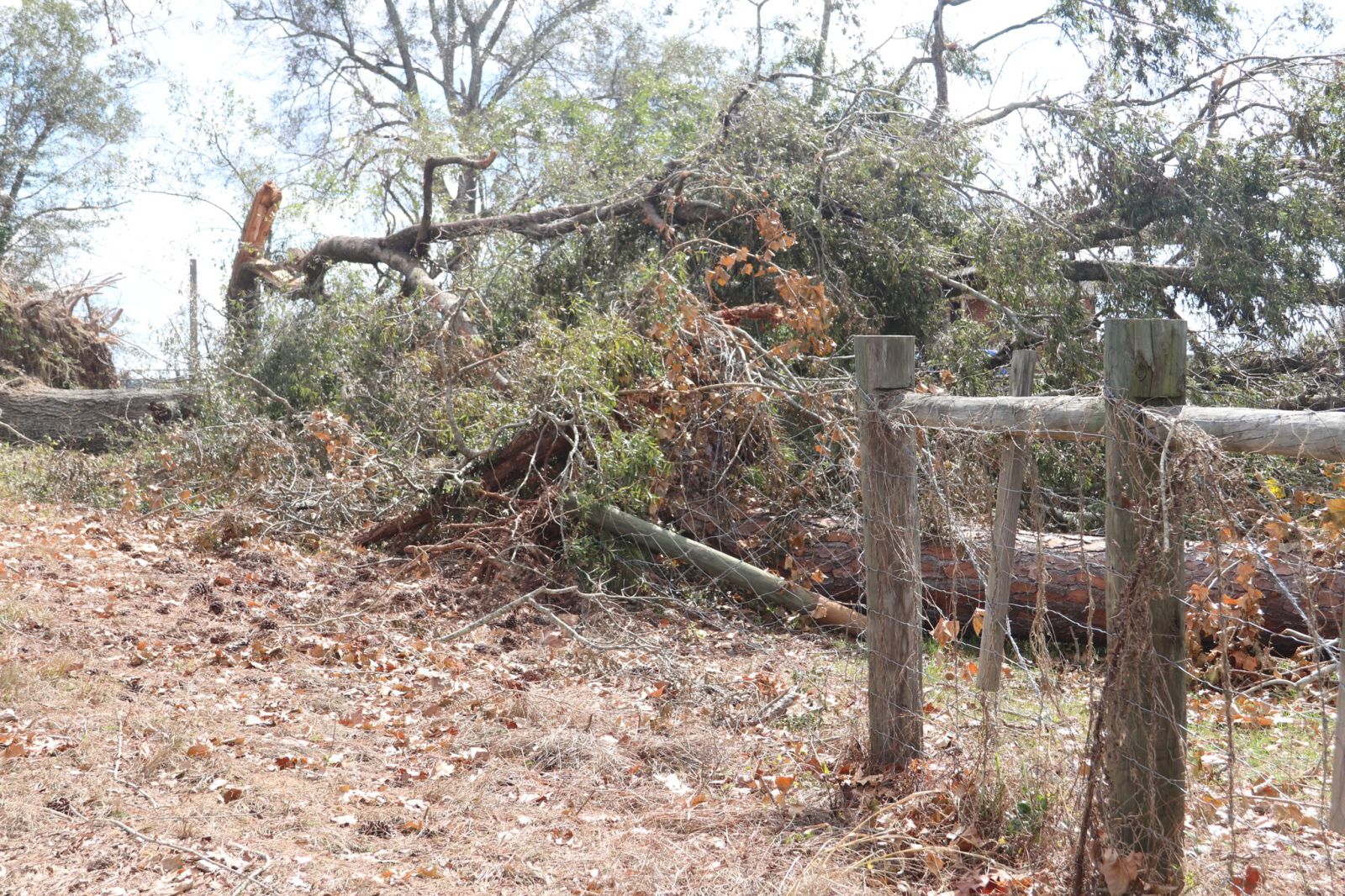
The Newberrys' fences were damaged in numerous places on their Jefferson County farm, in some cases allowing cattle to get out. / Photo by Jay Stone
VEGETABLES
UGA College of Agricultural & Environmental Sciences Dean Dr. Nick Place said Georgia’s fall vegetable crop accounts for 40% of the sector’s $1.2 billion annual production. Extension agents and farmers estimate 40% of the fall crop was lost to Helene with an estimated value of $100 to $120 million.

In Johnson County, Taylor Brett’s broccoli and cabbage crops took hits from the massive rainfall, which washed soil and plants down terraced fields, leaving small ditches behind and creating sand bars at the bottom. / Photo by Jay Stone
Brett double-crops his vegetables. He estimated a 10% loss from those he planted early, and the later crop might be down 50%.
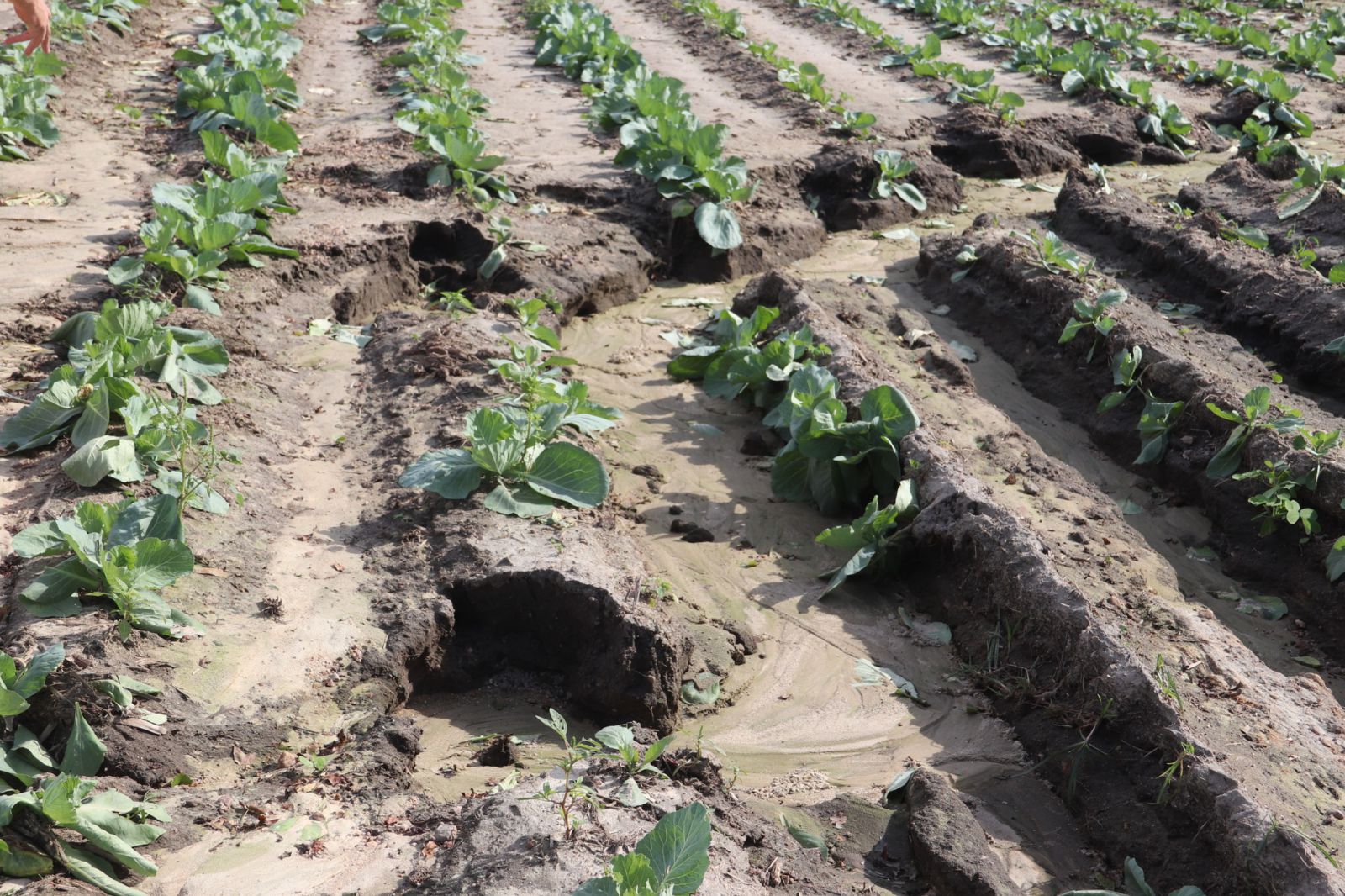
Taylor Brett noted some plants were washed away, some were buried, some were sandblasted and others were blown away. / Photo by Jay Stone
At Corbett Brothers Produce in Echols County, Helene damaged numerous equipment sheds and did minor damage to the operation’s packing shed roof.
“We had damage from Hurricane Idalia last year, but this is 10 times worse than Idalia,” Justin said. “We’ve got a lot more structure damage from this storm. We’re going to have drastically reduced yields, but it’s too early to say.”
Justin said that while he and his brother, Jared, do have crop losses, they still have viable squash, bell peppers and eggplants that they are working to harvest and keep young plants alive.
“We’re running the office and packing shed on generators but most of these generators are being used to run the well pumps in the fields to keep the crops watered so the plants can recover from the storm & keep producing vegetables,” Justin explained on Oct. 2.
Power was restored to the Corbett Brothers’ office and packing shed on Friday, Oct. 4. They turned off the last generator running irrigation on the last field the morning of Oct. 9.
DAIRY
Georgia’s dairy producers are estimated to have lost $75-$100 million in infrastructure damage, lost milk production and herd health issues.
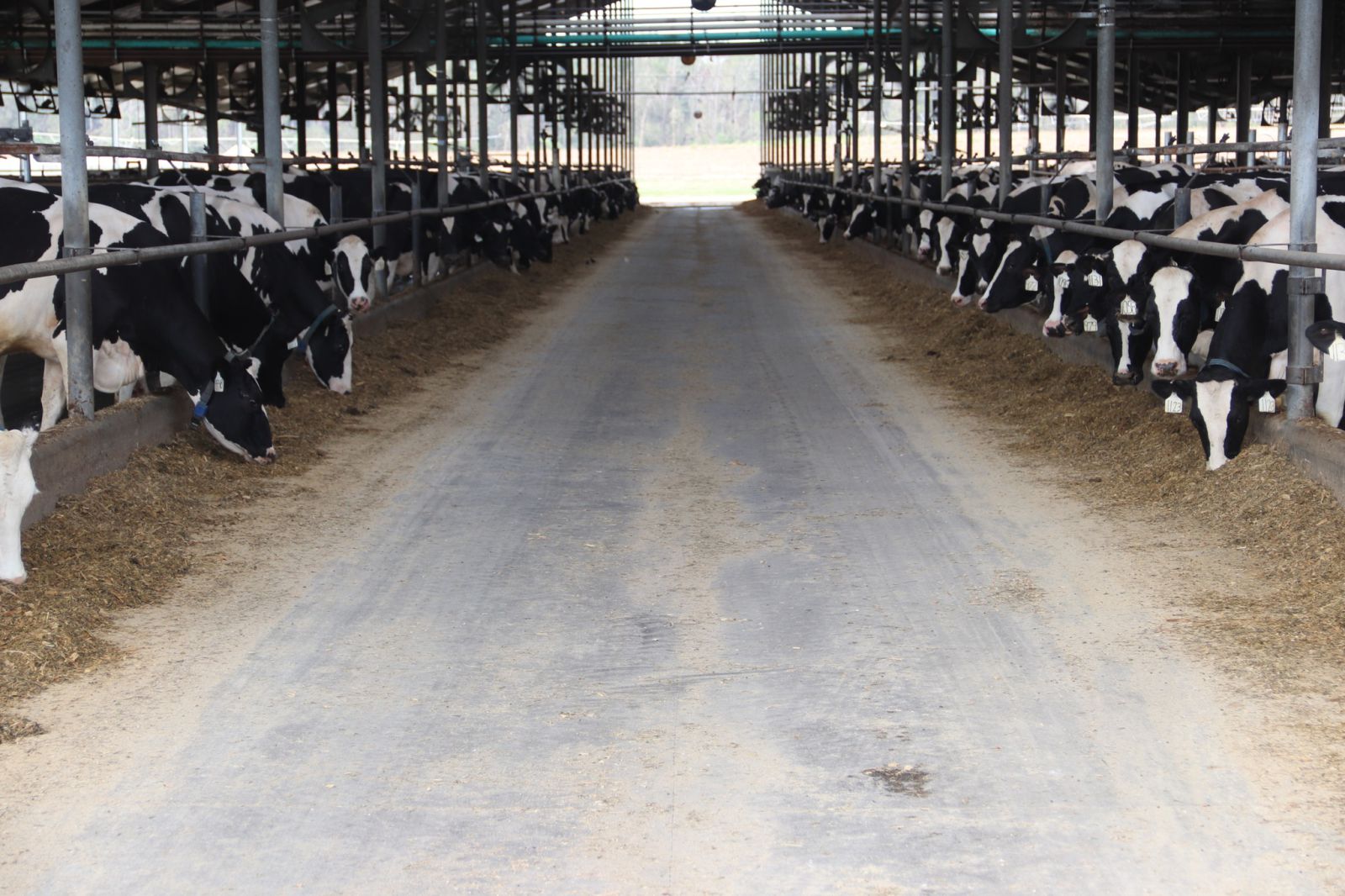
Cows eat at Hillcrest Farms dairy. A key challenge in the aftermath of the storm was that roofing was torn off the barn where feed components are stored, exposing the components to rain. While still edible, the feed had increased water content. According to Hillcrest Dairy Operations Manager Caitlyn, this resulted in diminished milk production. / Photo by Jay Stone
Hillcrest Dairy in McDuffie County has pastures Mark Rodgers couldn’t use for grazing because of downed fences. On Oct. 4 he said the dairy is not staffed to conduct fence work on the scale of the damage left by Helene.
“It may be months, a lot of months before we actually have livestock in there, because you have fences down, and we're going to have to hire somebody to come in and do that fence,” Rodgers said.
Compounding the fence problem, the storm blew the roof off of Hillcrest’s commodity shelter that houses bins where cattle feed components are stored. Hillcrest Dairy Operations Manager Caitlyn Rodgers said the ingredients they had on hand are OK to use, but they are saturated from rainwater, and the resulting extra water intake resulted in a loss of milk production, from approximately 29,000 pounds of milk per day to about 25,000 pounds per day.
“When you put water into silage, they're eating the amount that they would normally eat, but we're weighing it, and they're getting more water,” Caitlyn said. “You need energy and feed, so anytime that you have a horrendous amount of rainfall blowing up into the commodity shed, anything like that, you're going to see a drop in production.”
Hillcrest, Georgia’s first dairy to utilize robotic milking stations, continued operations through the storm, though three of the five robotic milking stations went down.
The Rodgers counted themselves fortunate that they did not lose any cows and all their family and staff are safe.
On Sept. 30, at least $10,500 worth of milk had to be dumped as a result of power outages, according to the Georgia Department of Agriculture. Right after Helene came through, there were 19 dairies statewide left without power operating on generators. As of Oct. 9, the number has dropped to five dairies without power.
PEANUTS
UGA’s preliminary damage report estimates Georgia has initially lost 5-7% of its peanut crop at an estimated cost of $50 million. Many growers ran peanut pickers late into the night on the days before Helene came through to pick as much of their crop as they could. However, much of the crop was still in the ground when Helene blew in, so, it’s likely peanut losses will increase by the end of harvest season.
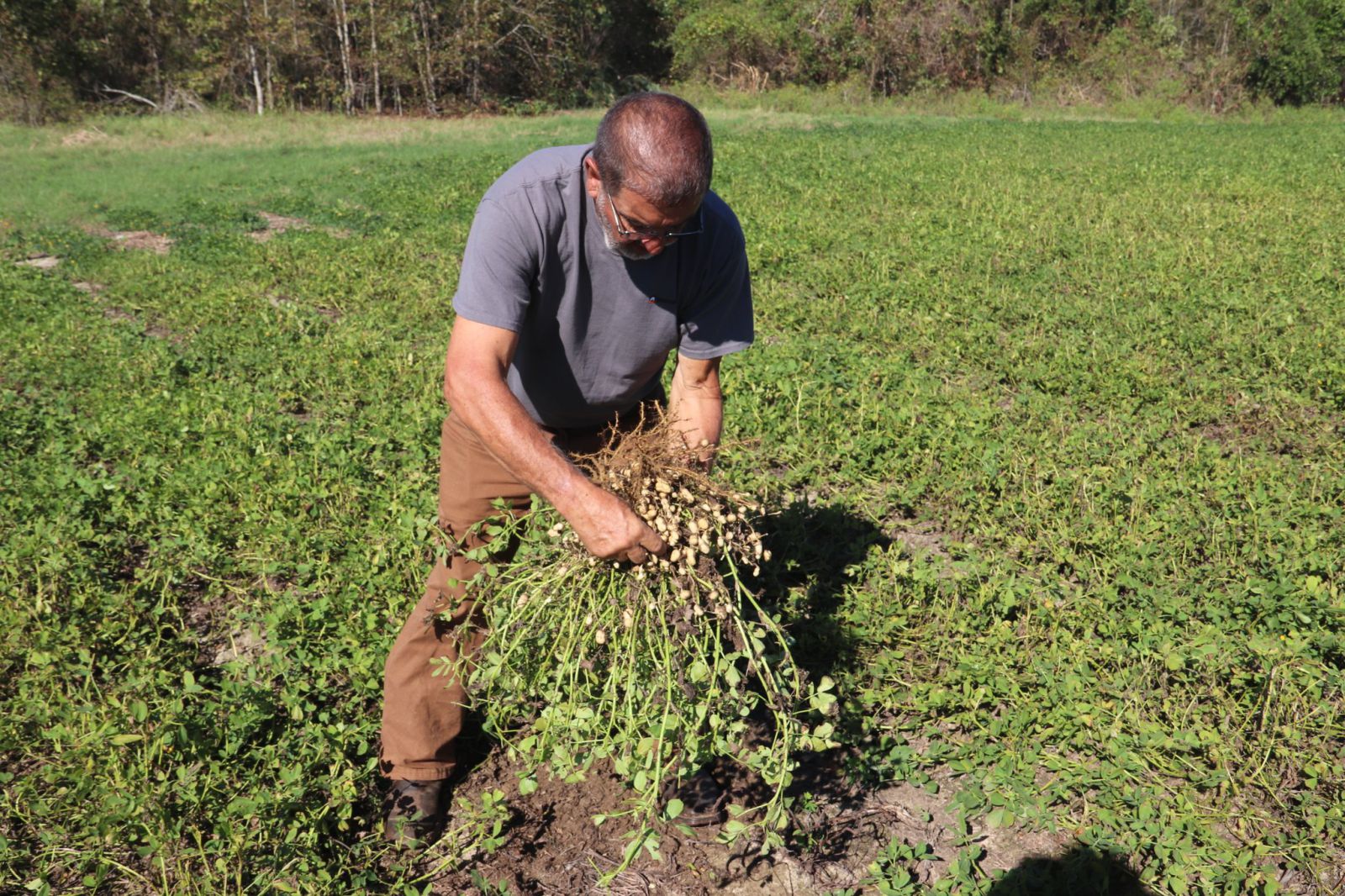
Johnson County Farm Bureau Vice President Hugh Veal examines his peanuts. He is concerned the crop may have quality issues./Jay Stone
The Veals in Johnson County were nearing time to harvest, but many a sampling of plants showed nuts that did not fill out the inside of their hulls. The hulls stayed wet for an extended period and mold developed inside.
In Ware County, David Morgan still had a power line across the entrance to one of his fields on Oct. 4, preventing him from harvesting it. / Photo by Jennifer Whittaker
He, like farmers all across Helene’s path of destruction, are also having to clear dirt roads of fallen trees and limbs.
“All of these peanuts are over mature. They’re ready to be harvested,” David said. “If they stay in the ground too long the peanuts are going to start falling off the vines.”
Another obstacle keeping farmers, like David, from harvesting their peanut crop is that numerous peanut buying points sustained damage that has to be repaired before they can process peanuts.
According to National Peanut Buying Points Executive Director Tyron Spearman, 29 peanut buying points in Hurricane Helene’s path from Valdosta to Augusta sustained some type of damage or lost power. As of Oct. 8, all the buying points are operating at some capacity. According to the Georgia Department of Agriculture, as of Oct. 9, 18 peanut buying points were still without power and 11 have been restored.
During a visit to Jeff Davis County Oct. 4, Archie Miller, manager of Jeff Davis Peanut & Grain, a peanut buying point serving farmers in 10 Southeast Georgia counties, was gracious enough to give a quick tour of his damaged facility. /Photo by Jennifer Whittaker
“We’re going to be running at 50% production at the very best,” Miller said. “The Lord will get us through this, but it’s going to take a while.”
The facility resumed receiving harvested peanuts from farmers the night of Oct. 3, Miller said.
Miller brought in generators from Florida and Alabama and secured some from farmers. On Oct. 4 he was having trouble getting some of them to work. Miller estimates it’s going to cost him $100,000/month to rent the generators not including the cost of diesel to fuel them.
An 110-foot peanut elevator that normally stands by storage bins was blown to the ground damaging a bin and shelter roof and knocking another bin over. At another elevator, The storm took out the transfer tube in another peanut elevator and damaged the peanut cleaner.
Miller said the buying point lost some of its trailers used to haul in peanuts from the farms and that half of its hauling trailers were turned over in farmers’ fields as of Oct. 4.
CITRUS
Georgia citrus producers lost about 40% of their crop according to UGA’s preliminary damage report issued Oct. 10. This represents a preliminary loss of $12 million.
TOBACCO
“Tobacco is usually a $16 million crop for our state and we’re estimating that preliminary losses for this year for Tropical Storm Debby at about $7 million,” UGA CAES Dean Dr. Nick Place said.
Place said at the Oct. 10 press conference that UGA CAES is estimating that between Tropical Storm Debby in August and Hurricane Helene there will be a $3.6 million loss in tobacco infrastructure to curing barns and equipment.
SOYBEANS
Preliminary losses for Georgia’s soybean crop are estimated between $6-$7million.
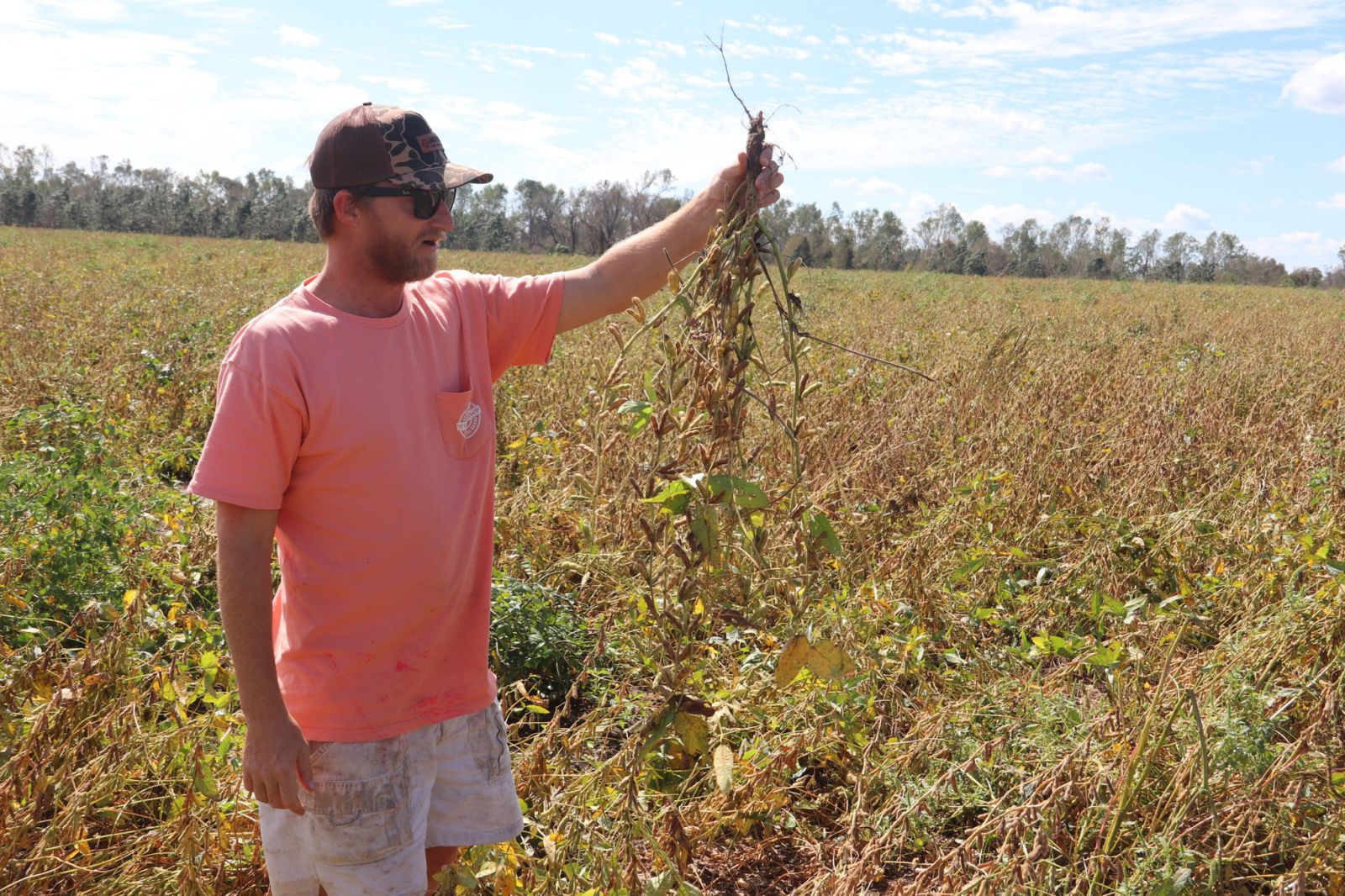
In Johnson County, diversified producer Taylor Brett had soybeans blown over and estimated between 20% and 50% yield loss of his soy crop. /Photo by Jay Stone
“That's gonna be a guaranteed rot,” Brett said. “Depending on how much is laid on the ground, we’ll have loss in yield and quality. The quality will go down because soybeans don't like getting wet and drying out multiple times.”
Brett also sustained damage to his grain facility and one of his nitrogen bins was toppled by Helen’s winds.
- Categories:
- Tags:
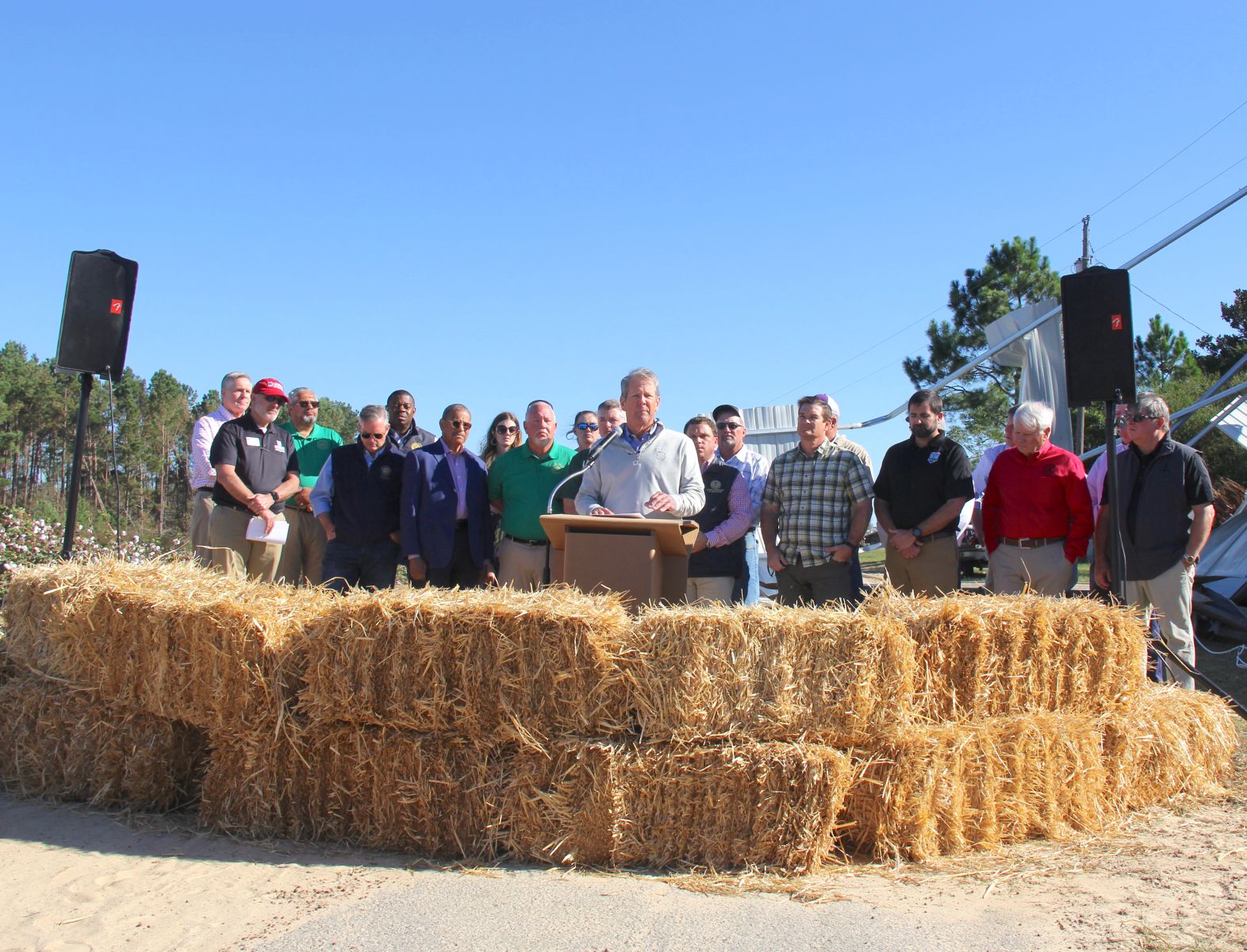

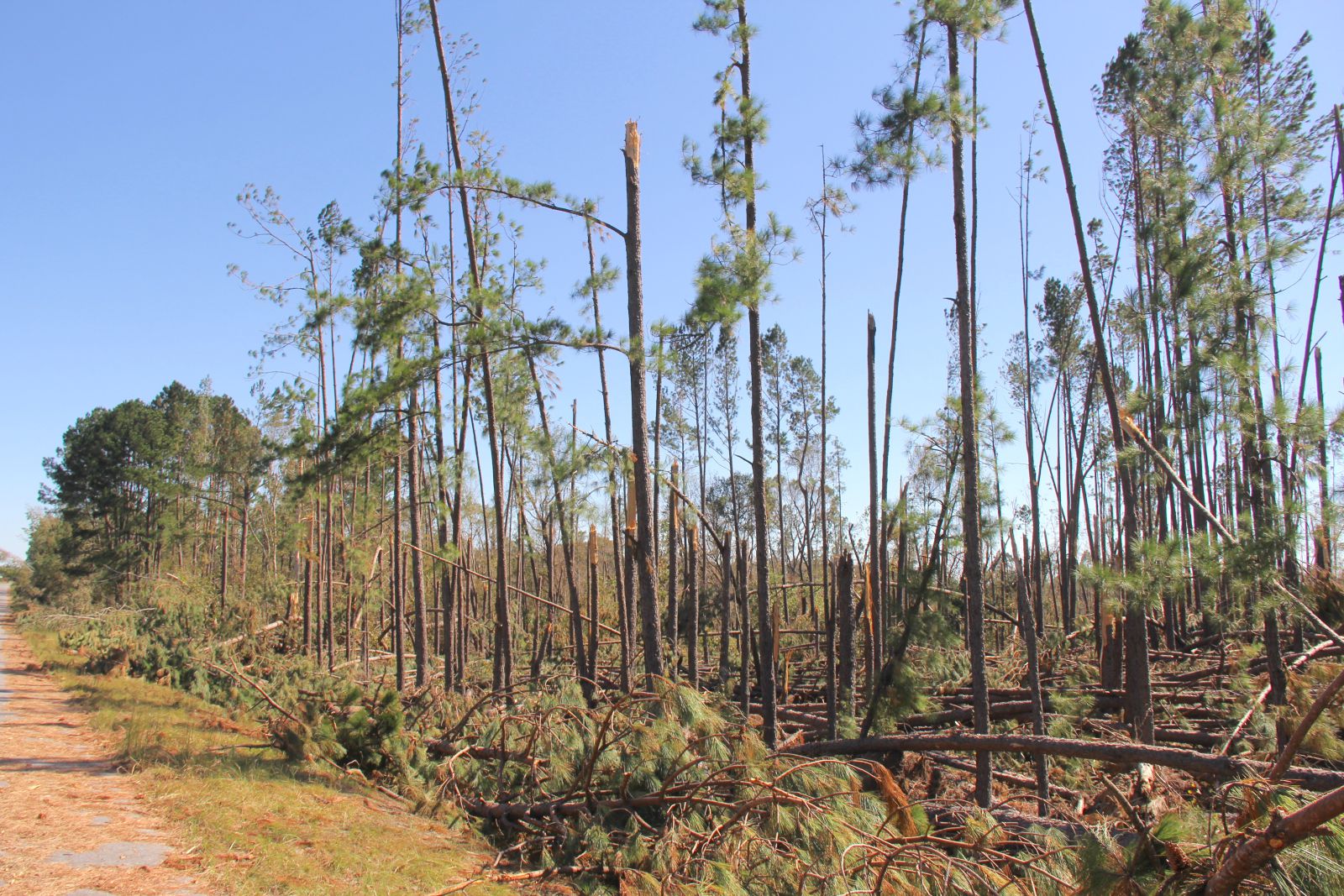
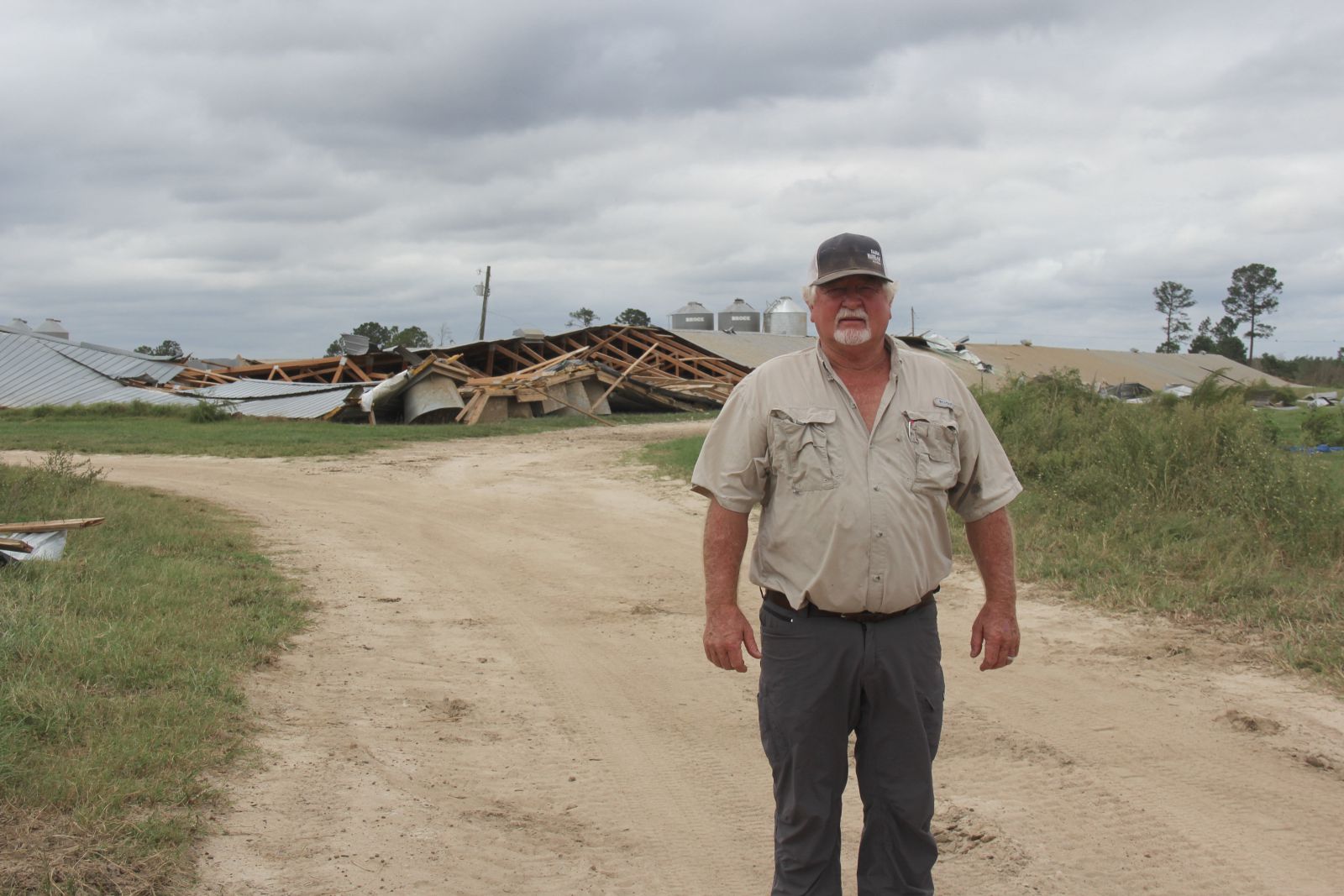
.JPG)
